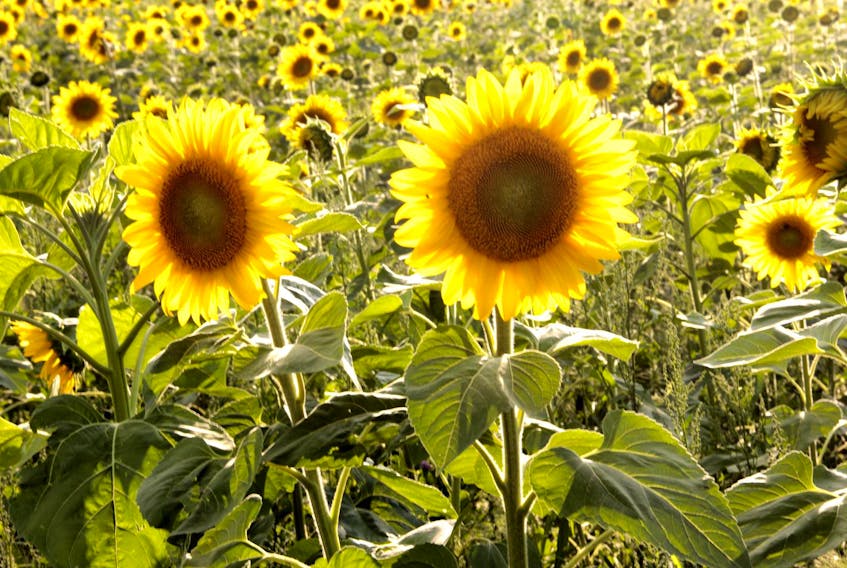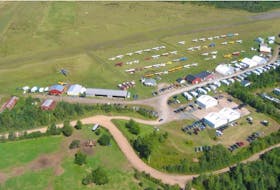If you aren’t lost in the grand view at the top of the hill, you may catch a glimpse of someone’s wishes still fluttering among the leaves in the field of sunflowers.
Ken and Jennifer Wilson of Dakeyne Farm, are growing old fashioned memories. From mid-August through September, people are invited to visit this historic farm, find themselves in a maze of sunflowers and simply get lost in nature.
“We’re open every day it’s not raining,” said Jennifer Wilson.
It took the Wilsons months of planning, plowing and planting to prepare this maze of sunflowers, which will fully bloom in stages that open every 10 days. The whole family is involved in the planning, producing and operation of the maze.
The children design the shape, Ken prepares the fields. The earliest section was planted to bloom when the maze opened in mid August, but the last field won’t come into its full glory until late September. Throughout the season the family takes turns operating the welcome centre.
Jennifer Wilson added the climate in Nova Scotia is too damp to successfully grow sunflowers as a cash crop, so they are planting these flowers to create an experience where people find their bliss while getting lost in a dazzling maze of natural beauty.
“There’s a reason that sunflowers don’t grow in Nova Scotia. It’s too wet, the heads turn mouldy,” she said. “What we are growing are unplugged memories that you can’t buy at the store.”
There’s a place where kids can play with toy trucks in the dirt, people can rent kites to fly, families can picnic and spend quality time together. Photographers and artists love the view. The maze is also available to host private events such as weddings.
It’s planted freshly each year in a new pattern that leads to the top of a hill overlooking the shore where Acadian dykes are nestled along the banks of the Avon River. This view changes during the day and throughout the season, as the sunflowers open in their times and follow the light of the day.
It will be a bright spot in the morning and shift midday, gradually leaning toward its grand finale bathed in a sunset of orange and purple near disk, she added.
Early in the season, the Wilsons sell a few special wishes along with the memories. For the past five years they have been importing a limited number of painted lady and monarch butterflies that people can purchase and release.
This tradition is based on a Native American legend that says if a butterfly is caught and released the Great Spirit will grant a wish. She added that the first butterfly release on the farm took place as part of her marriage vows and has since become an annual tradition at the farm.
“It is a moment with a beautiful creature, in a beautiful field, with a beautiful view,” she said. “The experience is unforgettable. It is fun and beautiful all rolled into one.”
The farm still produces cash crops like hay, barley, garlic, and beef, but during the late summer and early fall most of the attention is placed on growing beautiful memories for themselves and others. She added this new way of working the land came as a result of succession planning when her father –in-law was thinking about the future of the family farm.
Wilson said this land has been an important part of the family, a place for four generations to gather, work toward a common future and share memories along the way. Its location, about 10 minutes from Windsor, also makes it a prime space for real estate developments.
Tempting as a deal to subdivide the property could be, the family decided the best way to ensure their own future was to keep the land as it is and share it, growing rich experiences for other families.
“The land should remain as it is, not turned into a subdivision or a private property with one expensive house on the hill, this beautiful view shouldn’t be reserved for just one person to enjoy,” she said. “So the question was how do we keep the farm going?”
The Wilson family have been stewards of this place since 1935 when John Ingram Wilson purchased the property, which is a former training site for the British Home Children program. This program was active from about 1869 through 1939 and sent thousands of British children to Canada to work on farms and learn the skills of farming.
When this work program began to wind down after the First World War, Dakeyne farm eventually went on the market. In the early days, the farm made its living shipping barrels of apples overseas during the war, and supplying the Falmouth Fruit and Vegetable Company here at home. In time, the farm was passed on to the next generation of Wilsons when son Donald ran it mainly as a dairy farm.
Changes in the dairy industry that began in the 1970s made it increasingly difficult for small scale farmers to make a living, Jennifer Wilson said her father-in-law held on for as long as he could but finally sold his quota.
Don Wilson is still active on the farm, while Ken and Jennifer are managing the maze and daily operations. The idea to plant sunflowers began when the family was deciding the next logical steps for the land, which is a prime location for various development projects.
As you wander the maze, there are a series of 10 questions that you can answer. Picnic tables overlook a breathtaking view at the top and a little red house stands alone.
“People always tell me I should put a house up there, so I did,” she laughed. “There is so much history here, this land has not changed much since the Acadians. Cows are still grazing, we are still producing hay. It’s a beautiful place.”
RELATED:









